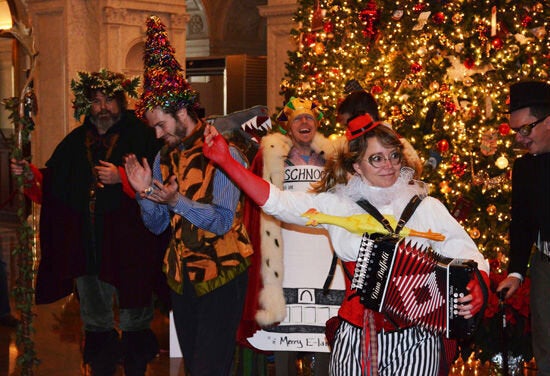
In case you haven't heard, in Philadelphia the "politically correct" crowd is on the warpath over a New Year's Day Mummers skit by Northwest Philadelphia's Venetian New Year's Association. The three-minute strut included a crude reference to "Indi-sourcing," in which members dressed in traditional Indian costumes managed a "New Delhi Call Center." In a parallel skit, other brigade members did a hybrid Native American war dance while wearing small feather war bonnets.
Sometimes it's fun to worry about inconsequential minutiae, but the fact is Native headdresses have been part of the Mummers for decades. Since the Mummers are about feathers, it should come as no surprise that some brigades would opt to use a Native headdress as part of its ensemble.
An important thing to remember when viewing the comic brigades is Jonathan Swift's famous line: "Nothing is above satire." This may be hard to swallow in our super hypersensitive age when good comedy sometimes takes a back seat to (yawn) sanitized political correctness. Unfortunately, we live in an era when people become "outraged" at the drop of a hat and at all the wrong things. Consider this: where was the outrage when President Obama signed the NDAA into law, which gives the government the right to arrest any American citizen and deprive them of legal representation after that arrest? Isn't this what they do in Red China, and what used to happen in Soviet Russia? Instead, people are "outraged" because a few drunken white men danced in a circle wearing makeshift American Indian headdresses.
"Racist inappropriate cultural appropriations!" the outraged proclaimed.
Let's back up a little.
Wearing Native American headdresses used to be a rite of passage for most American boys. My childhood Boy Scout troop, for instance, had many halo and straight-up Native war bonnets that we wore during Scout Jamborees in Maryland along the Mason-Dixon line. Dressed up, we built campfires, put on war paint, and hunted one another down in a great Native American fantasy that usually ended in a great bonfire and a circle dance. (Today, a bonfire would be outlawed as "dangerous" and war paint as "unacceptable.") Such ceremonies taught us to be respectful and to honor the American Indian. These rituals were the high point of camp life, so much so that for the longest time I wanted to be an American Indian. Pretending I was American Indian was such an intense childhood obsession I'd take my bow and arrow, spear and halo war bonnet and lead charges against my faux cowboy or Calvary friends on the steep hills behind my house in Chester County. I didn't care that I was the only kid playing the part of an Indian because I saw the American Indian as a scared underdog in an unjust war with the land-stealing Calvary.
The girls in my Chester County country neighborhood would often don a headband with one feather sticking straight up in the back. They played Native squaws. In those days, nobody thought that outdoor theater like this was disrespecting Native culture. If anything, the opposite feeling was usually present: by our dressing up as American Indians, we felt we were honoring our true American ancestors in a special way.
Today, more people are of the opinion that when white people wear a Native headdress they are committing an act of racism. I blame the fashion and design industry for this change because these are the industries that incorporated Native headdresses as sexy fashion accruements and put them on the heads of female fashion models in suggestive poses. You know what I'm talking about: sleek, practically nude models in war paint with a Native headdress cocked over one eyebrow. This trend began some time ago despite the fact that in Native culture only men wore war bonnets. There were women chiefs but they did not wear war bonnets; full feather war bonnets were for male warriors only. If you think that's sexism, history will tell you that it doesn't care. That's the way it was.
In November of 2011, a Denver-based fashion boutique was forced to change its website after a host of complaints regarding female models wearing Native headdresses in suggestive ways, which was seen as disrespectful. Sex ruins everything, as they say.
Of course, in the Mummers one can spot colonial costumes, men dressed as nuns or as Turkish sultans, pirates, priests, etc. And on any given Halloween, Center City is full of faux nuns, bishops and cardinals, not to mention impersonations of the opposite sex, a get-up that used to be considered a sexist social sin by orthodox feminists.
Two years ago, a male acquaintance of mine dressed up as a 19th-century Turkish sultan for a Halloween ball. He was walking with friends across North Broad Street when he was attacked by another man who said he was insulting Islam. My friend was beaten pretty badly and spent a day in the hospital.
Now, dressing up as a 19th-century Turkish sultan is something straight out of an MGM movie set. A costume like that, to the modern mind, has a storybook quality with only a vague connection to Islam. Yet somebody was outraged and took matters into their own hands.
Welcome once again to our super-hypersensitive world.